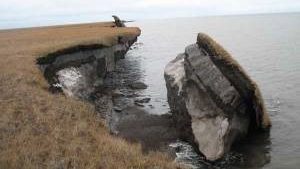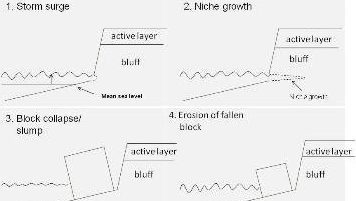Tom Ravens and collaborators are developing process-based coastal erosion models. In contrast to conventional models, these models account for the thermal and mechanical processes that are important in the Arctic. Importantly, these models are well-adapted to forecast future erosion rates in a warming Arctic. There are a number of mechanisms by which Arctic coastal erosion proceeds.One of the most dramatic mechanisms involves the thermal and mechanical cutting of a niche at the base of the coastal bluffs often during storm surges. This mechanism is predominant at Drew Point and other locations on the North Slope coast with high ice content and fine sediments.The niche grows until the overburden exceeds the bluff strength and block collapse results. An image of a fallen block and a conceptual model of the erosion mechanism are provided in the figure below (from Ravens et al. 2012).


Following up on this work, Tom and collaborator Li Erickson (USGS) are working to address other types of coastal erosion mechanisms. At the 2011 AGU Fall Meeting, Tom and co-authors presented preliminary work on a new coastal erosion model applicable at high coastal bluffs with high ice content and coarse sediments (e.g., Barter Island, Figure 8). At these sites, erosion proceeds via two complementary mechanisms. First, throughout the summer there is thaw slumping of the bluff face due to radiativeand convective heat transfer.Also, there are annual storm surges that transport the slumped sediment offshore. The thaw slumping and the annual storm surges together establish the normal beach profile which is much higher at the bluff toe than what is seen at a location like Drew Point. The normal yearly storm does not have sufficient surge to cause niche erosion. Occasionally, about every 10 years, there is a massive storm with a sufficient surge to cause niche erosion and block collapse. Figure 8 shows evidence of niche formation probably from the 2008 storm surge.
Documents:
Comments are closed